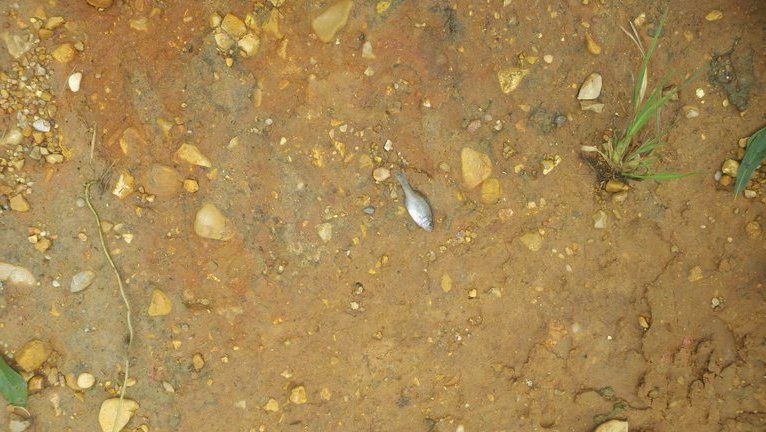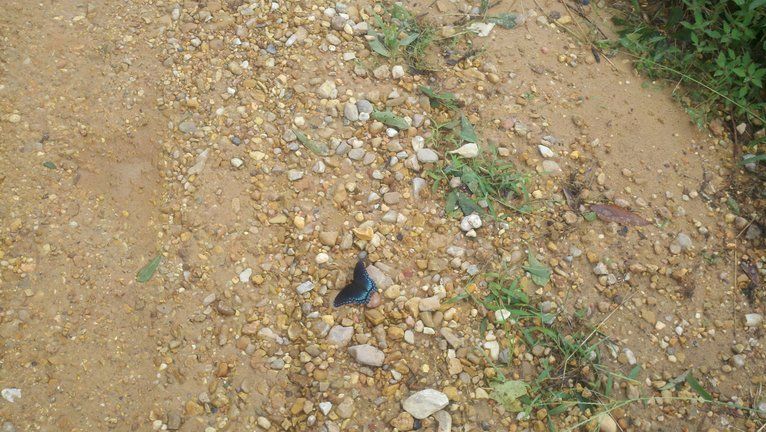 |
| Image provided to me by Little Walken |
Thursday, September 27, 2012
Guess the Genotype #88
So, I discovered today that a number of e-mails from y lovely readers were somehow lost in my inbox. I'm not sure how, but I swear I had never read some of them before. One of these e-mails is the source of today's Guess the Genotype. Can you guess this puppy's genotype? Its breed?
Wednesday, September 26, 2012
Why Tortoiseshells are Tortoiseshells
 |
| Tortoiseshell cats display a wide range of markings |
 |
| Torti with lots of black |
The exact mechanism behind a tortoiseshell's patch coat is actually quite fascinating. As with all X-Y animals, females don't necessarily benefit from having more than one copy of the X chromosome. The extra dose of genetic material can actually be problematic, so the body undergoes what it needs to for what is called dosage compensation. Basically, the body only wants to work with one chromosome at a time in each cell. Due to this, cells will undergo X-chromosome inactivation, packaging the material into a tiny bundle that is not usable. This little bundle is known as a Barr body.
 |
| A cell nucleus with a Barr body. Xi is the inactive chromosome in a Barr body, while Xa marks the active one |
 |
| Torti-tabby ("torbie") with lots of red |
 |
| A tortoiseshell with fairly even color distribution |
 |
| A calico cat |
If you see a male tortoiseshell or calico cat, it's likely to have a chromosomal abnormality such as Klinefelters syndrome (XXY) or some sort of mutation. There have been more than a few male tortoiseshells that have been found to be either chimeras, which have the DNA of two separate individuals, or mosaics resulting from some sort of mutation.
Also an interesting feature of tortoiseshells is that they cannot really be cloned. Since their coloration is based on random chromosome inactivation, the offspring will never look the same as its parent. In fact, it's more likely that the clone will be solid black or red rather than tortoiseshell since whatever cell that is collected from the donor will have already undergone the inactivation. Indeed, the first ever cloned cat, though cloned from a calico tabby, ended up a simple, uni-colored, black-pigmented tabby.
Sources are Texas A&M, Memorial University, Kimball's Biology, University of Miami, Messy Beast, Cat Fanciers' Association, Berkley, io9, and Dr. Sophia Yin. Images are from Wikimedia Commons under creative Commons licenses: one, two, three, four, five, six.
Tuesday, September 25, 2012
Ebon, Ebon, Ebon
So, I haven't really felt like I've had anything interesting to say lately. I drafted a few posts, but they were dry and I hated them, so thus the lack of...anything. I also got angry with my camera because it's making it more difficult for me to upload pictures. That didn't help.
Anyway, I'm going to get back into the swing of things. Here's some recent stuff with Ebon. Forgive me if the images are slow to load. My old uploading method automatically compressed the images down nice and small, but now I would have to compress them manually. So, these are not compressed at all. Hopefully I can work out an easier way of doing this.
And now for the coolest water fountain I've ever seen. It has three levels: one for adults, one for children, and one that's the perfect height for dogs! It's the only one like this in the park, with all of the others being the standard one- or two-level types. Even though there is only one, I'm glad they have it. The city's pretty dog friendly, and little touches like this make lives much easier for dog owners.
I do wonder, though, if this is kind of a leftover from when the park was even friendlier for dog owners. It used to allow provisional off-leash time, but there's now an ordinance that all dogs must be on lead at all times. I might have to take Ebon's long-line with me one of these days and make use of the huge green space at this park, while still obeying the laws.
That's it for our park day, but I do still have a few things to share:
I love this dog.
Anyway, I'm going to get back into the swing of things. Here's some recent stuff with Ebon. Forgive me if the images are slow to load. My old uploading method automatically compressed the images down nice and small, but now I would have to compress them manually. So, these are not compressed at all. Hopefully I can work out an easier way of doing this.
 |
| Ebom at the fountain in the big park downtown. The last time we were here, the fountain was decorated for Christmas |
 |
| Ebon enjoying the water |
 |
| Here, you can see where the spout is |
I do wonder, though, if this is kind of a leftover from when the park was even friendlier for dog owners. It used to allow provisional off-leash time, but there's now an ordinance that all dogs must be on lead at all times. I might have to take Ebon's long-line with me one of these days and make use of the huge green space at this park, while still obeying the laws.
 |
| After the park, we stopped at a nearby natural food market that's the sole supplier of certain products. Ebon got to drink out of my squeeze bottle while taking a little rest in the shade. |
I love this dog.
Wednesday, September 12, 2012
Thalidomide
Though you may not immediately recognize the name, this drug is infamous for what it did not so long ago. Beginning in the late 1950's and ending a few years later, it was prescribed to pregnant women as a treatment for morning sickness. What doctors didn't know then was some of the chemical's properties would cause some serious problems.
Thalidomide lead to approximately ten thousand birth defects as a result of its use. Though mothers were perfectly fine, the chemical interacted with the growing baby's body, resulting in such defects as misshapen ears or feet and even reduced, or worse, completely missing limbs. It was a major scandal, as you can imagine. Many parents blamed themselves for what happened, and there were even suicides. To make things worse, the company that made the drug was silent for years about what had happened. They didn't issue an apology until August 2012. That's right, August of this year. The apology led to a major backlash with many people, including a large number of those born with birth defects caused by Thalidomide use, saying it was "too little too late."
So, what makes the drug so bad? It has to do with something called chirality. Certain chemicals with the same formula (in the case of Thalidomide, C13H10N2O4) are able to bind in slightly different ways. These forms can result in minor changes to how our bodies react to them, or can lead to some surprising differences. For example, another chiral molecule, limonene, smells like oranges in one form (the R enantiomer), and the other form (the S enantiomer) smells more like turpentine. Why is this? The proteins in our body have receptor sights that are very specific shapes. If one enantiomer fits, it's highly likely that the other one will not. Instead, it's common for the two forms to react with completely different proteins and lead to very different results.
In much the same vein, Thalidomide causes very different reactions based on which enantiomer is present. The R form, seen to the right in the first image on this post, helps with morning sickness. The S form, to the left, is what caused all of the problems. It, unfortunately, got in the way of the normal development of a fetus.
Well, chiral molecules that occur in a racemic mixture (a mixture of both enantiomers) can be purified until only one enantiomer is present. So, why not do that? Then, it would treat morning sickness and not cause birth defects, right? Unfortunately, it's not that simple. Even when pure R-Thalidomide is given, the body freely converts the drug back and forth between the R and S forms. So, even if a patient is given only the beneficial enantiomer, some of the bad enantiomer will end up floating around in their blood stream. Even the good form is dangerous.
Interestingly enough, Thalidomide has not been completely taken off of the market. It is used to treat such diseases as leprosy, and is being researched as a treatment for cancer. It carries strong warnings about its potential for birth defects, but the side effects on the average, non-pregnant person are minimal. They are mainly limited to such things as dizziness and drowsiness.
Sources are the Thalomid Information, International Myeloma Foundation, PubMed Health, RxList, Drug Bank, Chinese University of Hong Kong, Ouvaton, Chirality & Odour Perception, MedicineNet, The New York Times, and Reuters. Images are from Wikimedia Commons under Creative Commons licenses or are copyright free: one, two.
 |
| One of these things is not like the other, one of these things can cause severe birth defects and lead to countless lawsuits |
So, what makes the drug so bad? It has to do with something called chirality. Certain chemicals with the same formula (in the case of Thalidomide, C13H10N2O4) are able to bind in slightly different ways. These forms can result in minor changes to how our bodies react to them, or can lead to some surprising differences. For example, another chiral molecule, limonene, smells like oranges in one form (the R enantiomer), and the other form (the S enantiomer) smells more like turpentine. Why is this? The proteins in our body have receptor sights that are very specific shapes. If one enantiomer fits, it's highly likely that the other one will not. Instead, it's common for the two forms to react with completely different proteins and lead to very different results.
 |
| One defect resulting from Thalidomide |
Well, chiral molecules that occur in a racemic mixture (a mixture of both enantiomers) can be purified until only one enantiomer is present. So, why not do that? Then, it would treat morning sickness and not cause birth defects, right? Unfortunately, it's not that simple. Even when pure R-Thalidomide is given, the body freely converts the drug back and forth between the R and S forms. So, even if a patient is given only the beneficial enantiomer, some of the bad enantiomer will end up floating around in their blood stream. Even the good form is dangerous.
Interestingly enough, Thalidomide has not been completely taken off of the market. It is used to treat such diseases as leprosy, and is being researched as a treatment for cancer. It carries strong warnings about its potential for birth defects, but the side effects on the average, non-pregnant person are minimal. They are mainly limited to such things as dizziness and drowsiness.
Sources are the Thalomid Information, International Myeloma Foundation, PubMed Health, RxList, Drug Bank, Chinese University of Hong Kong, Ouvaton, Chirality & Odour Perception, MedicineNet, The New York Times, and Reuters. Images are from Wikimedia Commons under Creative Commons licenses or are copyright free: one, two.
Monday, September 10, 2012
Guess the Genotype #87
Saturday, September 8, 2012
Crazy Plants: Bracatinga
 |
| The bright yellow flowers of a bracatinga (Mimosa scabrella) |
The bracatinga was a very important source of wood for the Brazilian railroads. Due to this use, and its rapid growth, the species is often planted as a source of fuel. It is also used as a shade tree and for ornamentation. It has also be used for making paper, fence posts, and, interestingly enough, as a food source for goats. The flowers can also be used for honey production.
Sources are Purdue University, Winrock International, World Agroforestry Centre, Encyclo, and Erika Styger, PhD. Image is from Wikimedia Commons under a Creative Commons license.
Wednesday, September 5, 2012
Name That Animal (Answer)
This is a legless lizard. Specifically, an Eastern glass lizard (Ophisaurus ventralis). You guys did a great job guessing! For those that are curious, I have absolutely no idea how it died.
When I spotted it from about fifteen feet away, I thought it might be a snake, but on closer examination (especially after I realized it was dead), I realized it wasn't. The head was all wrong! It didn't have a distinct neck like the local venomous species (except the coral snake, but it's hard to misidentify them), and the head was pointed, whereas the local non-venomous species has very blunt faces. Then, I looked even closer, checking for ear openings. Snakes so not have external ear openings, but this animal did. Thus, legless lizard. I did have to do a little searching to find the exact species, since there are four legless lizard species found in my area.
This particular species is found throughout much of the Southern United States, extending from Mississippi to North Carolina. It prefers sandy areas, so its presence where I am isn't that surprising. Though this specimen is fairly small, the species can grow up to forty-three inches, or over a meter in length.
As with many lizards, glass lizards can loose and regrow their tails. The fact that they will easily drop their tails, as if they were fragile, is why the group is known as "glass lizards." If you look closely at the first image, you can see a line on the tail. This is likely the growth point after it dropped its tail.
Name This Animal
I found it dead out by one of the dumpsters. I'm not looking for a specific name (though go for it, if you want!), but the general group. I'll be posting the answer later today.
You can click the images for larger views if you feel the need, but the quality will drop.
 |
| The body is maybe tweny inches long |
 |
| Closer view of the head |
Tuesday, September 4, 2012
Ebon's Mother
I was finally able to snag a good picture of her for the blog. Most of the pictures I have or can find aren't so great (example). This is Ebon's mother, Hellon, who will be fifteen this Christmas. She has some mobility issues (what dog this age doesn't?), but she's still doing pretty well. I kept miscalculating her age, but I know for sure now. She has the most fascinating graying pattern. I love looking at old dogs and seeing where and when they gray. A lot of them aren't as extensive as this!
Monday, September 3, 2012
Crazy Trip
I actually got back last night, but was really tired. In the end, I wasn't actually able to attend the funeral. Thanks to the hurricane, there was flooding that cut off the bridge to the chapel. The ground was also completely saturated, so we didn't even know when it would be possible to bury the poor man. Plus, there was a dam in the area that had suffered considerable damage and was at risk of breaking and causing serious flash floods. It was just a complete mess, but I was glad I was there, since we knew my grandparents were safe.
I took pictures, of course. Here's some of the damage we saw:
And here's some of the other pictures I took. Click for larger views.
I took pictures, of course. Here's some of the damage we saw:
 |
| The boys right by the flooding. Ebon wanted to wade in the water, so I had to leash him so he wouldn't be an idiot and get himself hurt. |
 |
| A casualty of the pond overflow, close to where Ebon is in the first picture |
 |
| A five foot wide chunk washed out of another dirt road |
 |
| Minor damage. These little leafy twigs were everywhere. |
 |
| A mailbox nailed by a falling limb |
 |
| The worst we saw at my grandparent's house: a minor roof leak. |
 |
| Some delicate creatures survived the storm unscathed |
 |
| On the way home we were treated to a double rainbow over Florida. Beautiful sight |
Subscribe to:
Comments (Atom)
















